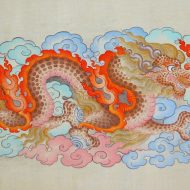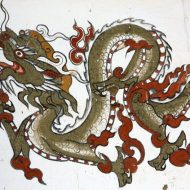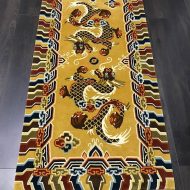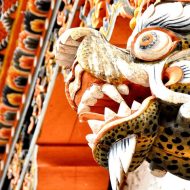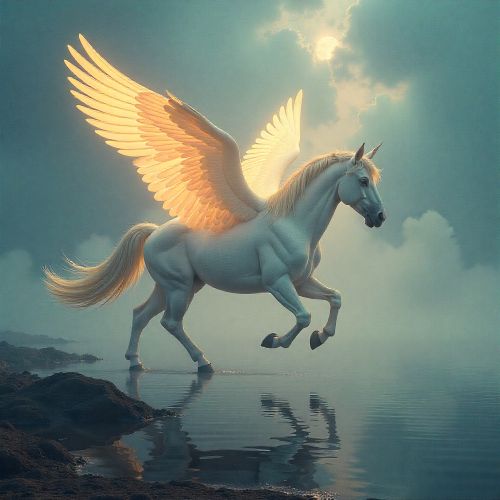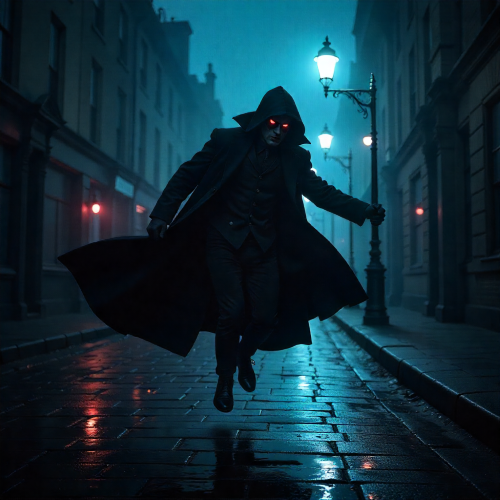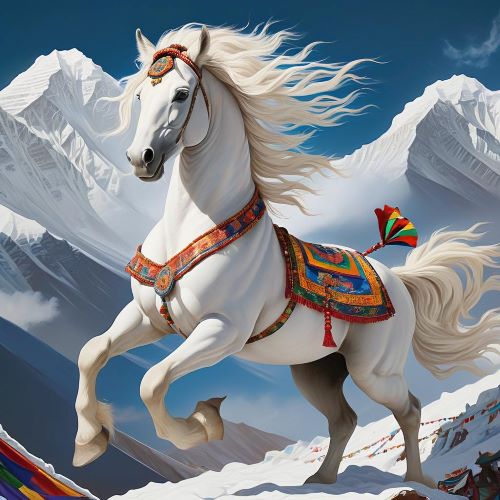Druk : The Thunder Dragon
Listen
At a glance
| Description | |
|---|---|
| Origin | Tibetan Mythology |
| Classification | Animals |
| Family Members | N/A |
| Region | Tibet |
| Associated With | Invisibility, Power |
Druk
Introduction
In addition to being mythical creatures, dragons are also an integral part of the culture and life of the Tibetan people. Like other Asian countries, they play an important role in the spiritual and cultural identity of the region especially since Tibet is additionally known as the “land of snow and dragons.” It took a long time before the teachings of Feng Shui and Zen could influence the local traditions of the Tibetan dragon.
It’s surprising that some elements of Indian folklore, such as the Naga, have infiltrated the ancient culture of Tibet. This occurred long before the Tang Dynasty’s influence was felt in the region. The cultural fusion between China and India suggests that Tibetans are more likely to perceive dragons as mythical creatures than their Asian neighbours.
Physical Traits
The Tibetan dragon is about 40 feet long, which is shorter than its Chinese cousin. Its thinness can be explained by how it adapted to the high altitudes in the region. Its body is also made up of vibrant colors, such as orange or red, because it doesn’t need camouflage. Its eggs are usually laid in snow, and its neck and head are smaller than that of the Chinese dragon.
Other Names
The Druk is also known as also called “dug”, “drug” or “zhug”. Their most common name however is either Tibetan Dragon, Thunder Dragon or Bhutan Dragon. Bhutan is called Druk Yul “Land of Druk”, and Bhutanese leaders are called Druk Gyalpo, “Thunder Dragon Kings”.
Powers and Abilities
The Tibetan dragon is a solitary creature that has the ability to communicate ideas and discern lies from fiction. According to Tibetan legends, it can also help people understand what’s real and is also known to spend time with monks. Although dragons are usually invisible to the human eye, they can still be found carrying a powerful thunderbolt, which can be used to awaken people who are in the wrong direction. This is a way to help them get back on track and avoid repeating their false beliefs.
As one of the four mythical creatures, Dragon represents power. The dragon thunders in the sky with the sound of compassion that awakens us from delusion and increases what we know through hearing. Thus, it can be said that dragons bring forth our awareness to things that we cannot see.
Modern Day Influence
According to a legend, Tsangpa Gyare, who is a well-known meditation teacher and the ancestor of Bhutan’s founding father, Zhabdrung Namgyel, was in a village in Nam to establish a spiritual centre. During his visit, he was reportedly able to see nine dragons flying across the sky. These creatures were said to have been able to trigger a loud clap of thunder as they moved away. He then named the area after the dragons.
Due to the importance of dragons in Tibetan culture, people have placed them on various objects, such as prayer wheels and prayer flags. They’re also commonly found on the roofs of Tibetan temples and traditional houses. The dragon is regarded as a powerful symbol of luck and can help people achieve good fortune.
The powerful creatures have been depicted in various forms throughout history. While the Western world is mainly known for featuring dragons in movies and television shows, Asian dragons are also widely seen. They are often depicted in clothing and other products, and they’re believed to bring luck and wisdom to people. Although most Westerners are scared of the evil depiction of dragons in their myths, many Asian people see them as benevolent and helpful.
Related Images
Frequently Asked Questions
What does the druk dragon symbolize?
The Druk dragon, or Thunder Dragon, is a national symbol of Bhutan, featured prominently on the country’s flag. It represents the strength and power of the Bhutanese people and is considered a divine protector against evil forces. The name “Druk” translates to “thunder,” linking the dragon to storms and natural elements. Associated with the Drukpa school of Tibetan Buddhism, the dragon shapes Bhutan’s spiritual landscape. Additionally, it symbolizes prosperity, abundance, and good fortune for the Bhutanese community.
What does the dragon symbolize in Bhutan?
In Bhutan, the Druk dragon symbolizes national identity, prominently featured on the national flag to represent the strength and resilience of the Bhutanese people. It serves as a guardian spirit, protecting the country from malevolent forces. The name “Druk,” meaning “thunder,” links the dragon to storms and the power of nature. Associated with the Drukpa school of Tibetan Buddhism, it reflects the country’s spiritual heritage. Additionally, the dragon symbolizes prosperity, abundance, and good fortune for the Bhutanese community.
What is the story of druk?
Why is Bhutan called Druk?
Bhutan is called Druk, which translates to “dragon” in the local language, symbolizing strength and protection. The name is linked to the Drukpa school of Tibetan Buddhism, founded by the saint Padmasambhava, which significantly influences the country’s spiritual practices. The dragon is a prominent symbol on Bhutan’s national flag, representing the connection between the people and their land. Bhutanese people often refer to their country as Druk Yul, meaning “Land of the Dragon,” highlighting their unique cultural identity
Why is Bhutan called the dragon kingdom?
Bhutan is called the “Dragon Kingdom” because of its national emblem, the “Druk,” which means “Thunder Dragon” in Dzongkha. The country’s mythology and historical narratives are filled with references to these legendary creatures. The dragon is a symbol of power, protection, and wisdom. Bhutan’s name, “Druk Yul,” literally translates to “Land of the Thunder Dragon.” Even the national anthem, “Druk Tsenden,” references the dragon.


